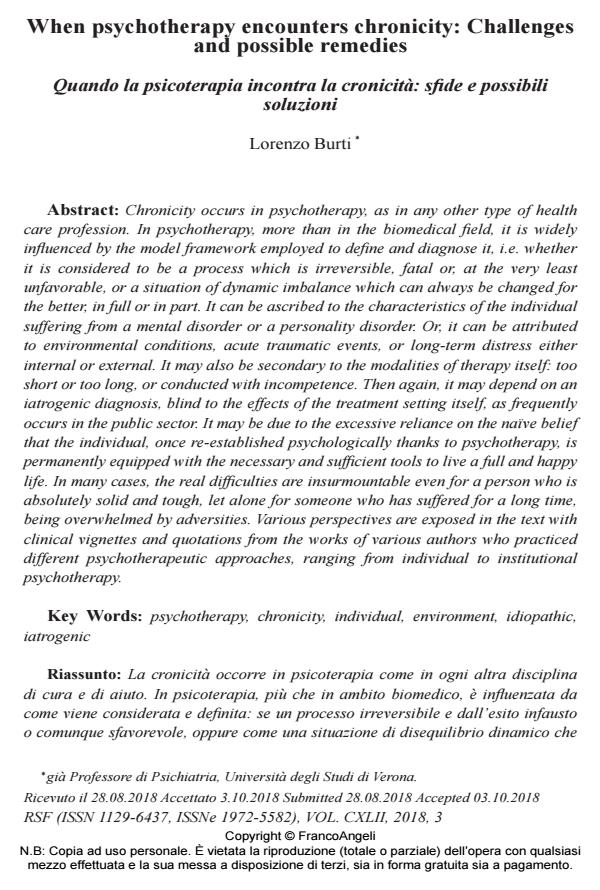When psychotherapy encounters chronicity: Challenges and possible remedies
Titolo Rivista RIVISTA SPERIMENTALE DI FRENIATRIA
Autori/Curatori Lorenzo Burti
Anno di pubblicazione 2018 Fascicolo 2018/3
Lingua Inglese Numero pagine 20 P. 97-116 Dimensione file 1854 KB
DOI 10.3280/RSF2018-003006
Il DOI è il codice a barre della proprietà intellettuale: per saperne di più
clicca qui
Qui sotto puoi vedere in anteprima la prima pagina di questo articolo.
Se questo articolo ti interessa, lo puoi acquistare (e scaricare in formato pdf) seguendo le facili indicazioni per acquistare il download credit. Acquista Download Credits per scaricare questo Articolo in formato PDF

FrancoAngeli è membro della Publishers International Linking Association, Inc (PILA)associazione indipendente e non profit per facilitare (attraverso i servizi tecnologici implementati da CrossRef.org) l’accesso degli studiosi ai contenuti digitali nelle pubblicazioni professionali e scientifiche
Chronicity occurs in psychotherapy, as in any other type of health care profession. In psychotherapy, more than in the biomedical field, it is widely influenced by the model framework employed to define and diagnose it, i.e. whether it is considered to be a process which is irreversible, fatal or, at the very least unfavorable, or a situation of dynamic imbalance which can always be changed for the better, in full or in part. It can be ascribed to the characteristics of the individual suffering from a mental disorder or a personality disorder. Or, it can be attributed to environmental conditions, acute traumatic events, or long-term distress either internal or external. It may also be secondary to the modalities of therapy itself: too short or too long, or conducted with incompetence. Then again, it may depend on an iatrogenic diagnosis, blind to the effects of the treatment setting itself, as frequently occurs in the public sector. It may be due to the excessive reliance on the naïve belief that the individual, once re-established psychologically thanks to psychotherapy, is permanently equipped with the necessary and sufficient tools to live a full and happy life. In many cases, the real difficulties are insurmountable even for a person who is absolutely solid and tough, let alone for someone who has suffered for a long time, being overwhelmed by adversities. Various perspectives are exposed in the text with clinical vignettes and quotations from the works of various authors who practiced different psychotherapeutic approaches, ranging from individual to institutional psychotherapy.
La cronicità occorre in psicoterapia come in ogni altra disciplina di cura e di aiuto. In psicoterapia, più che in ambito biomedico, è influenzata da come viene considerata e definita: se un processo irreversibile e dall’esito infausto o comunque sfavorevole, oppure come una situazione di disequilibrio dinamico che può essere comunque sempre modificata, in pieno o almeno in parte, nella direzione della salute. Può essere ascritta alle caratteristiche dell’individuo, colpito da un disturbo acquisito, o da un disturbo di personalità. Ma può anche essere attribuita a condizioni di origine ambientale, eventi traumatici acuti, o disagi di lunga durata, interni o esterni. Può anche essere secondaria alle modalità della terapia stessa, troppo breve o troppo lunga, oppure condotta in maniera incompetente. Ancora può dipendere da una diagnosi iatrogena, cieca all’effetto patogeno del setting stesso, come può più frequentemente accadere in ambito pubblico. Può dipendere dalla eccessiva fiducia riposta nella ingenua convinzione che l’individuo, una volta ristabilito psicologicamente grazie alla psicoterapia, risulti definitivamente equipaggiato con il bagaglio necessario e sufficiente per vivere una vita piena e felice. In molti casi le difficoltà concrete della vita sono insormontabili anche per una persona assolutamente solida e tenace, figuriamoci per chi ha sofferto, più o meno a lungo nel tempo, sopraffatto dalle avversità. Nel testo vengono esposte varie prospettive illustrate da casi esemplificativi e da citazioni tratte da opere di autori di diversi approcci psicoterapici che vanno dalla psicoterapia individuale alla psicoterapia istituzionale.
Parole chiave:Psicoterapia, cronicità, individuo, ambiente, idiopatico, iatrogeno
Lorenzo Burti, When psychotherapy encounters chronicity: Challenges and possible remedies in "RIVISTA SPERIMENTALE DI FRENIATRIA" 3/2018, pp 97-116, DOI: 10.3280/RSF2018-003006